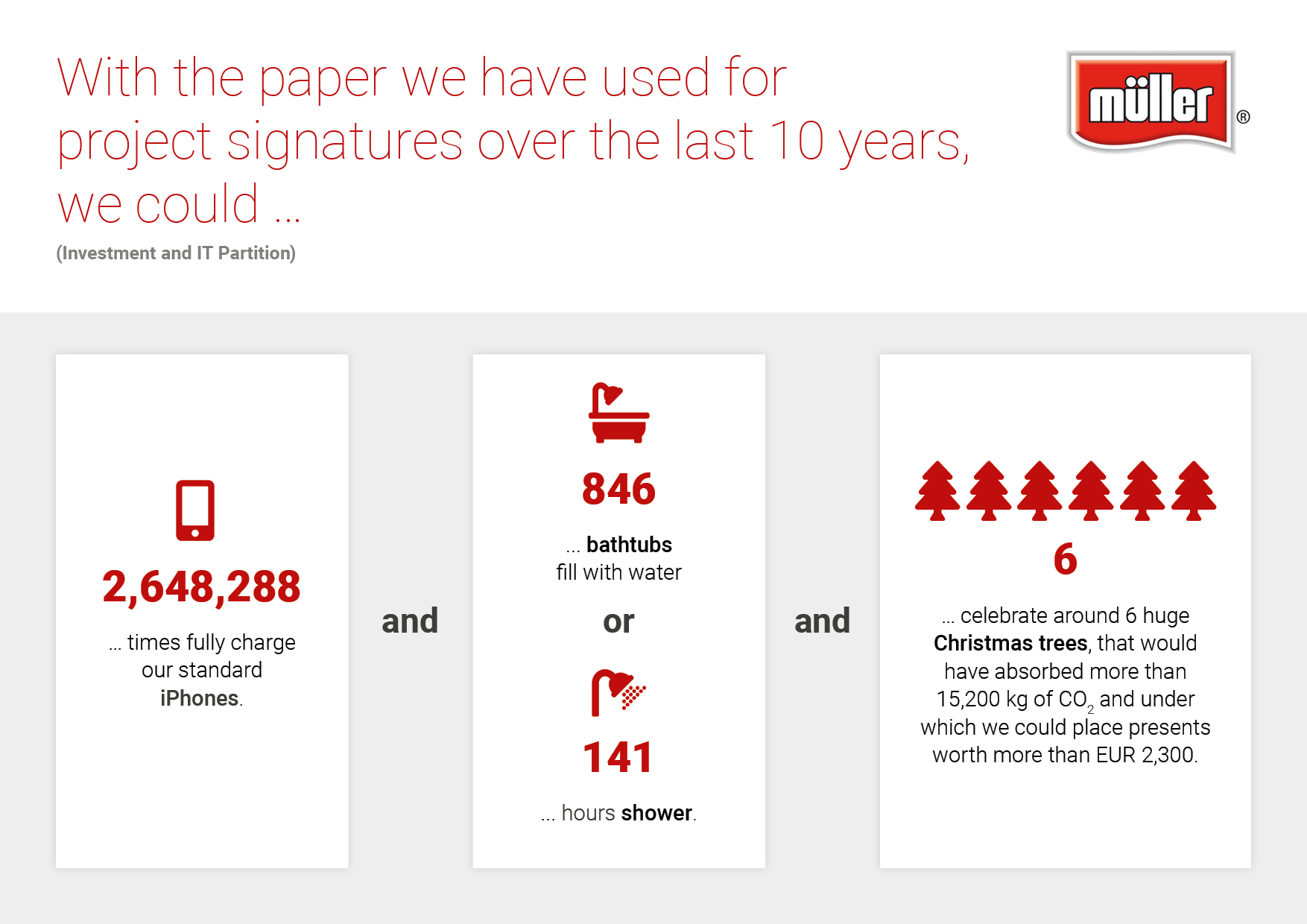Our Interviewee Introduces Himself
Hello, Mr. Schmidt! Could you please give us a brief introduction about yourself, what you do at Müller, and how you interact with Clarity?
I have been with Müller for almost 20 years now, and since 2005 I have been working in the Central Project Management department, which is now called the Project Management Center of Excellence. We’re responsible for project management at the Müller Group, meaning we oversee the methodology, the associated processes, and also the use of the Clarity project management tool. We started implementing the software in 2005.

Rolf Schmidt, Head of Project Management Center of Excellence
From Analogue Checklists to Digital Approval with Clarity
What made you decide to use Clarity to digitize the approval processes at UTM?
Müller generally has a strict principle requiring review by at least two people as well as corresponding approval hierarchies. Until only recently, we still had to get actual signatures from individuals for budget or project approval. Forms were constantly being sent back and forth, and analogue signatures were obtained. The signed request would be scanned and filed in Clarity via document management. Final approval would only be given once all this had been verified.
The analogue approval process was very cumbersome. It also took a really long time and had simply fallen behind the times. We really wanted to do away with all that: We wanted to be modern, faster, and more transparent. That’s why we launched the pilot project with itdesign in 2019. We wanted to introduce digital approval for all project phases in the IT and investment units, since large budgets need to be approved on a regular basis in these areas.
How do the digital approval processes work at your company today?
Today, we have a five-phase model in the investment and IT units. Five different gates must be approved for each project. Each gate involves different processes that have to be successfully navigated. The processes are structured in a very multilayered manner.
The project manager creates a project in Clarity and initiates the request. Depending on the budget amount, the request is then sequentially e-mailed to the various management levels – from plant or technical management to local management. In some cases, the request will go all the way up to the divisional management and company leadership. For simple projects where only a small budget needs to be approved, there may be three or four decision steps. For very complex projects with large budgets, there may be up to ten steps, however.
It also depends on the gate that needs approval: The initial phase of a project will have the planning release, for example. The implementation approval will come later. Implementation approvals usually involve much larger budget amounts, so there are usually a lot more steps. There are also more decision makers that need to involved in the process.
What has changed since the introduction of digital approval?
At Müller, the introduction of digital approval in Clarity has significantly sped up the entire process, from project request to approval. We have been able to measure this in the investment area as well: Throughput times have fallen by at least 30 percent thanks to digital approval. And we have achieved all this despite the fact that significantly more people are now involved in the approval process. We no longer need paper, either. Everything is now mapped digitally. Now you can see quite transparently where an approval is pending. You can also read at any time in the corresponding comments whether an action is still needed. We no longer have to wait until afterwards before manually checking if all the necessary documents for approval are available. It is now done automatically during the approval process.
What are the benefits for the stakeholders?
The project managers at Müller have shared very positive feedback with us about the digital approval process. At the push of a button, you can easily see where your approval request currently is as well as whether there are any queries. This offers them a certain level of security that they used to lack. Before, the project request was sent around to various approvers, and they had to wait for feedback from them.
What we have ended up doing is to start a kind of reminder e-mail, which is typically sent out on Monday, where we provide the respective decision-makers with an overview of the projects that are still awaiting their approval. This, of course, makes it easier for our project managers as well, since these messages are just “soft reminders“.
Using a project management tool generally translates into lots of administrative effort on the part of project managers. The digitization of the approval processes significantly reduces the scope of this additional work. They can start their projects much earlier because the processes go faster.
The primary benefit for the decision makers is probably that they no longer have to log in to Clarity separately to process a project request. As you might expect, our senior management in particular is not as familiar with the various tools. That’s where digital approval by e-mail via your own mobile device provides an ideal solution. The approval e-mail provides them with all the basic project information. All they need to do is press the corresponding button, and they can even do it from the road.
Transparency has improved a lot thanks to the new process, since more people are involved, such as employees in Controlling, who were previously only involved at a much more rudimentary level. Almost all the approvers can now also comment on a request, and these comments are read and documented.
The ability to track approval processes also gives the PMO a key advantage. This kind of transparency just wasn’t available before. A sheet of paper was sent out at some point, but no one really knew where it was at any given moment. As a result, the PMO wouldn’t really be able to provide any support or follow up. That has all changed now.
How has the implementation of digital approval affected the way in which Clarity is perceived inside the organization?
For the Müller Group, Clarity represents the definitive means of digitization. One key consideration is that digital approval makes the tool incredibly modern. The ability to use Clarity on your own mobile device in particular makes the tool versatile. We no longer need paper for the approval processes, and we don’t have to print it out or put a stamp on it. You automatically get the feeling that you can easily work inside a digital workflow, including even on the go.
Establishing the Digital Approval Process
How did you manage to promote and fully establish the internal approval process?
The need for digital approval was very obvious. There was also a lot of pressure right from the start to get it done. Even top management could sense the analogue approval processes were simply no longer up to date. At the same time, the project implementation was also an agile pilot project. So we could actually kill two birds with one stone. We had support right from the start, including from the boardroom. Now that is something that helps immensely with getting a project like this off the ground.
The agile methodology and breaking the project into small bite-size pieces were very helpful for gaining acceptance of the new processes and establishing them at the business. That way very early on we could see the results, which only needed to be gradually refined later on. The managers responsible for the individual partitioning were also fully integrated into the project and could actively participate in it. Some of the potential points of friction were thus eliminated right from the start.

Illustration: Müller used this chart to help promote adoption of the new approval processes internally.
You have completed the pilot project for digital approval in the IT and investment units. Are there plans to now go ahead and roll it out to other areas?
Naturally, we’ve had to advertise the new digital approval process extensively within the business. Some of the divisions can’t wait to implement something similar. Some people are especially interested in the ability to approve projects via their mobile device. Our marketing manager, for example, wants to be able to approve his new product projects with his mobile phone. We now want to gradually integrate these and other innovations into the approval processes of other divisions‘ as well. One such innovation would be the validation of individual fields at the start of a process.
Agile Project Management as a Key Success Factor
Did the agile approach contribute to the success of the project? Would you do it that way again?
Yes, the pilot was definitely very successful. Especially when it comes to projects where you can split up the final outputs, the agile methodology just works better. And that was the case with us: We had a really high number of processes that needed to be integrated. With an agile approach, we could spread the processes out over time and show some initial results early on. We then implemented further refinements iteratively.
After the first project phase, in which we initially introduced as well as implemented simple requirements, we did a review. I would recommend that any company that wants to establish new processes (or tools) implement a six-month live phase for testing the processes. This allowed us to determine which optimizations and further requirements we still needed to implement in the project. These and other “luxury requirements” were then addressed in the next step, which was the follow-up project. Here, too, we have now been able to work through the long list of requirements that really made it possible for us to implement the digital approval feature. It contains a number of very advantageous features. I’m really happy with it now. Everything fits like a glove.
Collaboration with itdesign
How were we able to help you implement your digital approval processes?
As has been the case with all the projects we have completed in the past, itdesign supported us by generously sharing their expertise and commitment about digital approval implementation. The long-standing partnership paid off here as well in our search for a solution: itdesign understands our pain, our systems, and how we work. Of course, this has been, and remains, extremely helpful to us as we look for an appropriate solution.
For the digital approval project, it was also very important that both we and itdesign be very flexible as regards the original specifications. We discussed suggestions openly at all times, and we were always able to come up with a solution.
The itdesign project team was also very intensively involved in our agile workflow. They regularly participated in our dailies, for example. Both sides thus always stayed well informed, and you gave us immediate feedback on any outstanding items. I believe it is this kind of open approach to one another, including being open to suggestions and criticism, that has allowed us to collaborate successfully.
Download Summarized Success Story
Unternehmensgruppe Theo Müller
In 1971, Theo Müller took over his father’s dairy in Aretsried, Bavaria – at that time with only four employees. It is the starting point for the Unternehmensgruppe Theo Müller, which today operates successfully worldwide in the food sector. The Müller Group comprises activities and numerous strong brands in the dairy, deli, and services business. UTM shapes the industry not only in Germany, but also internationally – whether in the United Kingdom, Poland, or Italy: The products are number one on the market in numerous segments.
- Lebensmittelindustrie
- 26.600 Mitarbeitende
- Firmensitz in Luxemburg
- 1896 gegründet
- 19 Produktionsstätten weltweit
- Clarity & itd Advanced Resource Planning
Experience Clarity Live!
We would be happy to demonstrate the features of Clarity to you in a live system. Let us know what you are particularly interested in, and then we can arrange our first web session together.





